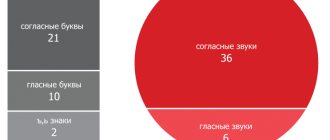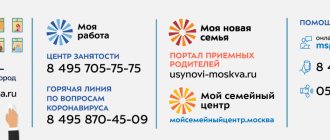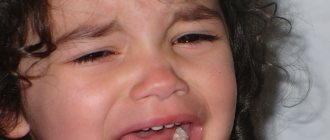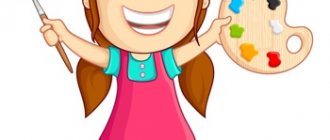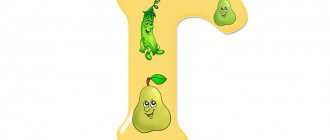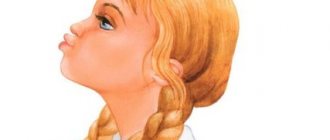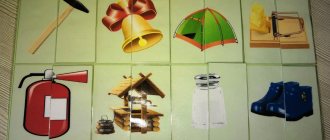Features of the dynamic side of speech
1. Pace (normal, fast, slow)___________________________________________
2. Rhythm______________________________________________________________________________
3. Correct use of pauses ___________________________________________________
4. Use of the main types of intonation (narrative, interrogative, incentive)_________________________________________________________________
Reproduction of the sound-syllable structure of a word
| older | older | will prepare | will prepare |
| house, snow, roof, bridge, porridge, bread, cat, cabbage, tomatoes, draft, frying pan, temperature, whistle, birdhouse, aquarium, medicine, curdled milk, snowdrop | |||
| The boys made a snowman. A plumber fixes a water pipe. Hair being cut in a barbershop. A policeman rides a motorcycle. A traffic controller stands at an intersection. |
Phonemic awareness state
1. Repetition of syllables with oppositional sounds:
From 5 years
pa-ba ____________ ba-na _____________ wa-ta ___________
ta-da _____________ me-ma _____________ na-ga ___________
ta-na _____________ ga-da _____________ ka-ga ____________
From 6 years old
ba-ba-pa ____________ ta-da-ta ____________ ha-ka-ga ___________
ba-bya-ba ____________ sa-sha-sa ____________ zha-za-zha _________
cha-sha-cha ____________ for-sa-for _____________
Differentiation of oppositional sounds that are not mixed in pronunciation
Show pictures
:
Bear-mouse _________________ duck-fishing rod ________________
barrel-bud ____________________ grass-firewood __________________
3. Differentiation by hearing of sounds mixed in pronunciation:
bowl - bear __________________ rat - roof _________________
river - radish __________________ bangs - crack ________________
flower-Svetik ____________________ wind-evening __________________
goat braids _______________________
State of phonemic analysis and synthesis
from 5 years:
1. Isolating a given sound [m] or [r] from words. According to the task, find out whether the sound [m] (mooing of a calf) or the sound [r] (motor) is heard in the words: mouse, mosquito, board, window, frame, house, fish, firewood, table, ball _____________________________________________________________________
2. Emphasizing the stressed vowel at the beginning of a word (“Tell me, what is the first sound in the word?”):
Anya, stork, wasps, duck, Olya, Ira, Inna, street ____________________________________________
from 6 years old:
1. Definition of the first consonant sound in words (“Tell me, what is the 1st sound in a word”?): poppy, smoke, grass, cat, sparrow, bun, cup, pike __________________________________________
2. Definition of the last sound in words: house, poppy, reed, key, tank, fly, drum, pipe
__________________________________________________________________________________.
3. Determining the sequence of sounds in a word (“What sounds are in words?”): poppy, soup, onion, porridge, frame ___________________________________________________________________________
4. Determining the number of sounds in words: house, cancer, moon, owls, banana, lamp
__________________________________________________________________________________
Speech Comprehension Study (Impressive Speech)
Passive dictionary
· Vocabulary volume ________________________________________________________________
· Accurate understanding of word meanings_____________________________________________
Show me where the doll, table, chair are.
Plant a doll, a bear, etc.
Understanding different grammatical inflections.
· Differentiation between singular and plural nouns
Show me where:
table - tables ____________ house - houses _____________ chair - chairs _________
tree—trees __________ birch—birches _________ cup—cups _________
pencil - pencils _____________
· Distinguishing prepositional-case constructions with prepositions (in, on, by, under, over, before, behind, about).
Show where the spoon is: in the glass, on the glass, under the glass, etc.
__________________________________________________________________________________
· Differentiation of prepositional-case constructions with prepositions in - from, on - with, under - from under:
Take a ruler from the pencil case, from the pencil case, from under the pencil case _____________________________________________
Put the pencil in the pencil case, on the pencil case, under the pencil case _________________________________________
3 Differentiation of word formation forms.
· Differentiation of diminutive nouns (show where)
house - house _____________ chair - high chair ___________
blanket - blanket __________ pillow - pillow ___________
lock - lock _____________ mushroom - fungus ___________________
doll - doll ______________ cup - cup _________________
* Differentiation of verbs with different prefixes:
walked _______ left _______ entered _________ left __________
moved ______ came in _________ left ___________
Understanding phrases and simple sentences (show)
Collocations
key pencil _________________ key pencil _______________
where is the owner of the dog __________________ where is the owner's dog _______________
mother's daughter _________________________________ daughter's mother _____________________
Offers
The girl picks flowers. ______________________________________________________________
Girl playing with a ball ____________________________________________________________
The girl is cleaning the room. ___________________________________________________________
5. Understanding interrogative sentences:
Who is the girl catching? _______________________________________________________________
How does a girl catch a butterfly? ______________________________________________________________
Who catches the butterfly? _________________________________________________________________
From 6 years old
Understanding complex and complex logical and grammatical structures
Petya catches up with Misha. Who runs first? _____________________________________________
A boy runs from a dog. Who's running behind? ___________________________________________
Olya lost the pencil she took from Vova. Whose pencil was this? ____________________
Dad was reading the newspaper after he had lunch. When did dad read the newspaper: before lunch or after lunch? _________________________________________________________________________________
Study of vocabulary and grammatical structure of expressive speech
· Name pictures by topic
Name a group of objects in one word
| Specific nouns | |||
| older | older | will prepare | will prepare |
| toys | |||
| dishes | |||
| cloth | |||
| shoes | |||
| vegetables | |||
| fruits | |||
| furniture | |||
| Dick. alive | |||
| house. alive | |||
| trees | |||
| flowers | |||
| transport | |||
| tools | |||
| berries | |||
| birds | |||
| heads headdresses | |||
| insects |
| Generalizing concepts | |||
| older | older | will prepare | will prepare |
| toys | |||
| dishes | |||
| cloth | |||
| shoes | |||
| vegetables | |||
| fruits | |||
| furniture | |||
| Dick. alive | |||
| house. alive | |||
| trees | |||
| flowers | |||
| transport | |||
| tools | |||
| berries | |||
| birds | |||
| heads headdresses | |||
| insects |
· Name nouns denoting parts of the body, parts of objects
From 5 years
· Body parts: head, legs, arms, nose, mouth, chest, stomach, neck, etc.______________________
· Parts of clothing: sleeve, collar, button_____________________________________________
· Parts of furniture: back, leg, seat_________________________________
· Parts of the car: door, wheels, steering wheel, cabin ___________________________________
From 6 years old
· Body parts: elbow, knee, fingers, nail_________________________________
· Parts of garments: collar, cuff, loop________________________________
· Car parts: body, cabin, headlights, engine___________________________
· Window parts: frame, window sill, glass ___________________________________________
· Names of professions ______________________________________________________________
__________________________________________________________________________________
__________________________________________________________________________________
· Verb dictionary. Use of verbs when answering questions.
From 5 years
· What do you do during the day? _________________________________________________
· How does one move? ______________________________________________________________
· Who is screaming? ______________________________________________________________
From 6 years old
Who does what (using job titles)? _________________________________
__________________________________________________________________________________
· Adjectives
Name of flowers
: white, black, red, blue, green, yellow, brown, pink, blue, orange ________________________________________________________________
Form name:
round, square, triangular, oval, rectangular ____________
__________________________________________________________________________________
· Selection of antonyms (from 6 years old):
big - long - full -
tall - wide - thick -
stupid - sweet - a lot -
close - good - easy -
Inflection state
1. Use of nouns in the nominative singular and plural:
| older | older | will prepare | will prepare |
| table | |||
| cup | |||
| pencil | |||
| house | |||
| chair | |||
| tree | |||
| window | |||
| bucket | |||
| bee | |||
| cucumber | |||
| sparrow | |||
| dress | |||
| egg | |||
| ear | |||
| a lion |
2. The use of nouns in indirect cases without a preposition:
I have a pencil (doll). I don't have a pencil. ___________________________________
I have no … ______________________________________________________________________
I'm drawing …_________________________________________________________________________
Dad writes …_______________________________________________________________________________
3.Use of the genitive plural form of nouns:
| older | older | will prepare | will prepare |
| ball | |||
| birch | |||
| table | |||
| cup | |||
| house | |||
| book | |||
| tree | |||
| ball | |||
| sheet | |||
| key | |||
| chair | |||
| pencil |
Distinguishing oppositional phonemes by ear based on words
Instructions:
“If I name the picture correctly, clap your hands; if I name it incorrectly, don’t clap.” Pictures: sled, hat, old lady, chick.
| Suggested material | Answers |
| Beginning of the year | The end of the year |
| Shanky - funky - syanky - sled - tanks | |
| Slyapa - shyapa - flyapa - hat | |
| Ftarufka - old woman - staluska - old woman - old woman | |
| Little bird - little bird - little bird - little bird - little bird |
Rating: 5 points
— all tasks were completed correctly;
4 points
- some tasks are completed with an error, but the error is corrected independently;
3 points
- errors are corrected after replay;
2 points
- some tasks are inaccessible and require replay when completed;
H point
- failure.
Studying the differentiation of sounds in pronunciation
Series "A". Repetition of popular words.
| Mixable sounds | Suggested pairings | Beginning of the year | The end of the year |
| Sh-S | Teddy bear - bowl | ||
| J-W | faces - roses | ||
| WHAT | bangs - chick | ||
| Ts-S | heron saber | ||
| S-h | helmet - pitching | ||
| Ch-Shch | bangs - slit | ||
| L-Y | pebble-nut | ||
| L-L | jackdaw - pebble | ||
| R-L | cancer - varnish | ||
| R-Y | brand - T-shirt | ||
| RH-I | sailor - lighthouse | ||
| P-B | kidney - barrel | ||
| T-D | wheelbarrow - dacha | ||
| K-G | bones - guests | ||
| Y-I | mouse - bear | ||
| NW | braids - goats |
Series "B". Repetition of phrases:
| Suggested material | Answers |
| Beginning of the year | The end of the year |
| The older brother was telling a scary story. | |
| The old woman was drying her fluffy fur coat. | |
| The river flows, the stove bakes. | |
| Julia dropped the porcelain saucer. | |
| A seagull is different from a heron. | |
| Sonya has seven flowers. | |
| It's terrible for a beetle to live on a bitch. | |
| Mice lived in the house. |
Score for task 4 (“A”, “B”): 5 points
— all tasks were completed correctly;
4 points
- there are isolated errors that are corrected independently, the task is completed at a slightly slower pace;
3 points
, the task is completed at a slow pace, there are many errors, some errors are corrected independently, some tasks are inaccessible;
2 points
- tasks are completed with errors, most tasks are unavailable;
1 point
- inadequate answers, refusal to complete.
Direction 7
Studying the formation of syllable structure and sound content of words.
Reflected word recall
Instructions:
“Listen and repeat after me.
| Suggested material | Answers |
| Beginning of the year | The end of the year |
| Hippopotamus | |
| Pine | |
| Tankman | |
| Draft | |
| Medicine | |
| Pan | |
| Thermometer | |
| little penguin | . |
| I'm taking pictures |
Grade:
5 points
- all words are accurately reproduced;
4 points
- most words are reproduced accurately, but the pace of reproduction is somewhat slow, there may be stutters;
3 points
- words are reproduced at a slow pace, with hesitations, 1-2 words with distortion of the syllable structure;
2 points
- most words are reproduced with distortion of the syllable structure, repeated presentation of the material is required;
1 point
- refusal to complete, inadequate answers
2. Reflected phrase playback
Instructions:
“Listen to the sentence and repeat exactly as I did
».
| Suggested material | Answers |
| Beginning of the year | The end of the year |
| The hockey players won the tournament. | |
| Larisa knitted a jumper for her brother. | |
| In the morning swallows chirped in the trees. | |
| Sasha returns from work in transport. | |
| Mom buys fruit at the supermarket. |
Grade:
5 points
— all phrases are accurately reproduced;
4 points
- basically all phrases are reproduced accurately, with a slightly reduced tempo and hesitation;
3 points
are noted for distortion of the syllabic structure of words, substitution of words, distortion of the structure of sentences without distortion of meaning;
2 points
- numerous distortions of the syllabic structure of words, sentence structure, both without distortion of meaning and with distortion, repeated presentation of the material is required;
1 point
—refusal to activity, inadequate answers.
Direction 8
Learning phonemic analysis skills.
Task 1. Instructions:
“Listen to how I pronounce the sounds: A, O, M, U, S, R, I (pronounced with exaggerated articulation). Let’s play a game: I will pronounce different sounds, and you clap your hands only if you hear the sound A.”
| Suggested material | Answers |
| Beginning of the year | The end of the year |
| a, o, p, y, a, i, m, e, a, s; | |
| pa, oh, aw, ma, you, ah , uh; | |
| Alik, beetle, horse, poppy, nose, winter, juice. |
Task 2. Instructions:
“I made a lot of sounds, and you say one sound.”
| Answers | |
| Beginning of the year | The end of the year |
| Suggested material | Answers |
| Beginning of the year | The end of the year |
| Remember and name the first sound: A, O, U | |
| Remember and name the last sound: O, T. M |
Task 3. Instructions:
“Let's play a game. Guess who's standing first and who's last. (The experimenter offers to choose from three toys placed in a row in front of the child; swaps the toys, and the game is repeated). And now I will make different sounds. I will say them in order: first the first one, then the other one, and finally the last one. So, I’ll name three sounds, and you...”
Task 4 Instructions :
“I’ll say the word, and you...” (Pronounces the word with exaggerated articulation).
| Suggested material | Answers |
| Beginning of the year | The end of the year |
| remember and name the first sound: in the word “Olya” | |
| remember and name the last sound: in the word “cat” |
Task 5. Instructions:
“Tell me, how many sounds are in the word “poppy”?”
| Beginning of the year | The end of the year |
This task is offered to children over 5 years old.
Score for tasks No. 1, 2, 3, 4, 5: 5 points
— all tasks were completed correctly;
4 points
- basically all tasks were completed correctly, errors were corrected independently or with the help of a clarifying question;
3 points
- tasks are completed with errors, which are corrected with the help of an adult, the pace of completion is slow, one or two tasks are inaccessible even with help;
2 points
- significant assistance from an adult is required when completing; some tasks are inaccessible even after using the “sample analysis” technique;
1 point
- inadequate answers, refusal to complete.
Direction 9
Study of connected speech
The development of the proposed materials was carried out based on the research of R. I. Lalaeva (1998); G.A. Volkova (1993); ON THE. Tsypina (1994). 1. Retelling of an adapted text of a narrative nature. (The text “Ducklings” is used from the manual by M.I. Omorokova, 1999). 1.1. Brief introductory conversation on issues
· Who has what kind of mother? (Chicks..., ducklings...).
· What do chickens hatch from? What about the ducklings?
· Who hatches chicken eggs? What about duck ones?
· How do you understand the phrase “hatch eggs”?
· Who can swim: chicken or duck, chickens or ducklings?
1.2. Reading a story .
One housewife wanted to raise ducklings, but she didn’t have a duck, she only had a chicken. The hostess bought duck eggs, put them in a basket and sat the chicken on them. The hen hatched the ducklings. She was happy and taught the children how to dig up worms. One day, a chicken took the children to the shore of a pond. The ducklings saw the water and rushed into it. The poor hen got excited, she ran along the shore and screamed, but the ducklings did not even think of going ashore. They swam happily in the water.
Perception and differentiation of speech sounds
Distinguishing voices and intonation of speech Examples of exercises.
• “Who is speaking?” The voices of people close to and unfamiliar to the child are recorded on a tape recorder, saying:
sharing a short poetic passage, as well as the child himself. Please identify the voice.
• “Is this a question?” We pronounce short phrases with different intonations (exclamatory, interrogative, declarative), asking the child to answer the question if asked: “There is a chair. Is there a table? This is a bear! etc. Then you can invite the child to switch roles.
• "I am angry". We pronounce neutral phrases with different intonations (sad, happy, angry, affectionate). We ask the child to guess when the voice is angry.
Differentiation of phonemes similar in acoustic-articulatory characteristics
Phoneme differentiation is carried out in the traditional way using diagrams. Voiced - dull, hard - soft sounds, whistling - hissing sounds, sonorators, affricates and their components, only correctly articulated by the child, are differentiated. For each pair of sounds, 2-5 sessions are sufficient, depending on the severity of the disorder. If there are substitutions in the child’s speech, the number of lessons on differentiating these oppositional sounds can be increased. Let's look at the example of differentiating the sounds “r - l”.
• The child is presented with short words: lak - cancer; lama - rama.
We clarify whether the words denote the same objects, whether they sound the same.
We show pictures so that the child can see that words have different meanings. We compare the words according to their sound composition and find out that they differ only in the sounds “r” and “l”.
• Discrimination of oppositional sounds based on tactile and visual analyzers. Scheme: sound “r” -
bell, sound
“l”
- steamer (by articulation).
Looking in the mirror, we pronounce the sound “r”,
analyze the articulation in detail, and compare it with the diagram: the tongue trembles just like the tongue of a bell.
Looking in the mirror, we pronounce the sound “l”,
analyze the articulation in detail, compare it with the diagram: lips smile - waves, the tongue looks like a steamboat, the sound
“l”
looks like a steamship whistle.
We ask you to pronounce the sounds “r” and “l” one by one,
pointing at the same time to the diagram.
• Distinguishing oppositional sounds in syllables. First we pronounce closed, then open syllables with the sounds “r”, “l”,
pointing out patterns of sounds.
• Distinguishing oppositional sounds in words: arrange the pictures in two columns under the diagrams
(sound "r"
the sound
“l”)
with the obligatory analysis of words according to the location of the sounds
“r”, “l”;
name vegetables, fruits, dishes, etc., the names of which contain the sounds “r”, “l”\
name words (select pictures) in which the sounds “r”, “l”
are at the beginning, middle, end;
replace the sound "r"
to the sound
“l”,
and vice versa (based on pictures):
spoons
-
horns, needle
-
game, spinning top
-
Yura
, etc.;
add (remove) sounds “r”, “l”
in words to get new words:
bot - board - bolt, that - cake, gas
-
eye;
determine the positions of the sounds “r”, “l”
in words like:
Lara, fisherman , etc.;
arrange the pictures in two columns under the diagrams: “r l” -
bell, steamer;
“lr”
- steamer, bell;
rearrangement of sounds, syllables in words: ra, la
-
Lara
, etc.
• Distinguishing oppositional sounds in sentences:
add the correct word to the sentence. Two words are called: horns, spoons.
You need to insert them into sentences:
The goat has small... There are teapots on the table...;
determine which words in a sentence contain the sounds “r”, “l”
and their position (according to the diagram):
Roman swam quickly.
Lara was knitting a red sweater. Etc.
• Distinguishing oppositional sounds in texts: pronouncing pure phrases (with preliminary
analysis);
recite short poems by heart (with preliminary analysis).
Development of skills in elementary sound analysis and synthesis
Development of elementary sound synthesis skills
When performing all exercises, the time between the sounds pronounced by the speech therapist gradually lengthens from 1 to 5 seconds. After reaching a five-second pause, the exercises are repeated in a more complicated version - during pauses a signal is made with a sounding toy or musical instrument.
• Synthesis of monosyllabic words from 3 sounds: ox, tank, bough, catfish
, etc.
• Synthesis of words from 4 sounds (one syllable) with a combination of consonants: temple, gnome, sort, pile
, etc.
• Synthesis of words from 4 sounds without a combination of consonants (two open syllables): mountains, chickens, cloud
etc.
• Synthesis of words of 2 syllables with a combination of consonants: moles, clubs, nipple, crust, T-shirt
etc.
• Synthesis of words from 3 open syllables: rams, paper
etc.
Texts for differentiating words with opposition phonemes
Galya and Kolya went with dad to the garden. There were many butterflies in the garden. Galya said: “Daddy, look how many butterflies there are here.” “Yes,” said dad, “a lot.” You see, one sat on the fence. Lock gate and sit on the bench. Let's watch the butterflies. Then we will catch some butterflies for the collection. You will put them in a beautiful folder with a butterfly on the cover.”
There was a ball in the palace . One courtier tripped and fell to the floor. He hit his leg and felt severe pain. “It hurts,” he shouted. “Come on, ” the king told him, “he who is not old should be cheerful. You will not receive from me the gift that I wrote to you about . You can leave the hall ." “Okay,” replied the courtier, “when a new day comes, only a shadow will remain of me here .”
One day Tom got lost and couldn't find his house. There was a high fence around the house, and next to it stood a large white cathedral. Tom galloped along all the roads and looked for the cathedral. Salty sweat poured from his forehead in streams. He could not find either the cathedral or the fence. was walking towards me . Bill said to Tom, “You must have had some whiskey today. After all, your home is nearby, Tom. Go home quickly, light the fireplace, dry yourself and warm up. After all, you were wet in the rain for a long time and could have caught a cold.” “Thank you, Bill,” said Tom, “this is truly my home.” Here is the cathedral, here is the fence.”
Dictionary recovery
The word is the basic semantic unit of speech. If you ask any person what human speech consists of, he will answer: words. In this regard, regaining the ability to understand and pronounce words is of utmost importance.
In patients who were “speechless” and, as a result of work on disinhibiting speech, began to pronounce individual sounds and syllables, words with a simple structure should be formed. At the same time, these words should be well known and often used. These include, for example, words such as “yes”, “no”, “give”, “want”, “can”, “will”, “okay”, “thank you”, “hello”, “bye” and etc. These words are suitable for answering many questions and, to a greater extent than others, serve the purpose of communication. By using them, the patient becomes convinced that he has ceased to be “speechless.” To reinforce these words, special questions may be presented during the day, as if provoking the patient to answer with the right word. For example: “Are you going to have lunch?” - "Will"; “Are you going to watch TV?” - "Will"; or “Do you want to have lunch?” - "Want"; “Do you want to watch TV?” - “I want”, etc.
In addition to these words, it is necessary to restore words - names of objects. This work begins by showing pictures by the names of the objects depicted on them[11]. At first the number of pictures is limited to three to five, then it gradually increases. It is useful to show pictures with any of the characteristics of the object. In this case, one of the most important is the functional sign, indicating what the main purpose of the item is. It is indicated by the question: for what? For example: what is a spoon for? (to eat, for food). In addition to functional ones, quality characteristics (shape, size, color, material), as well as such conceptual characteristics as “living-non-living”, “moving-not moving”, “thing-not-thing”, etc. are of great importance.
To practice each of the signs, the patient is asked, for example, to show where what is being written is depicted; what is used to cut; what they drink from; what they sit on, where something is depicted that is made of wood; what is made of iron; where what is round is depicted, what is long, where “living” is depicted, where “non-living” is depicted, etc.
Practicing these features allows one to approach generalizations and combine words into large groups (categories).
Usually the dictionary is systematized by topic: clothing, dishes, furniture, transport, art, etc. The meanings of words are clarified by introducing them into sentences with different meanings (i.e., in different semantic contexts). This technique is called semantic play. For example, playing on the word “glasses,” you can introduce it into the following phrases: “These are my glasses. Glasses are needed to see better. I need new glasses. Glasses are sold at the pharmacy. The doctor wrote out a prescription for glasses. Glasses preserve vision. Wear dark glasses to protect from the sun. A girl wearing beautiful dark glasses was walking along the beach. I'm happy with my glasses. The glasses fell and broke. I forgot my glasses at home and can't work. Glasses, etc. suit my friend very well.”
Each of these phrases, as it were, “highlights” the shade of meaning that is the main one in this sentence and allows you to concentrate the patient’s attention on it. In addition, the technique of semantic play demonstrates the polysemy of a word and helps to overcome subtle impairments in speech understanding, which always occur to one degree or another in aphasia. The phrases in which the word is introduced can be presented to the patient in a ready-made form for reading and comprehension, but you can also give them a different form - skip the word being practiced so that the patient finds and enters it on his own. For example, “I began to see worse, and the doctor prescribed new ones...” (glasses). Finally, you can give the patient the task of coming up with different sentences with this or that word.
The work of restoring the understanding of a word makes it easier to find the right word. The words included in the system are easier to remember, and it is easier for the patient to find them.
Below is didactic material on restoring the dictionary.

